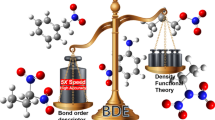Abstract
Thermal stability of energetic materials is often screened by differential scanning calorimetry and accelerating rate calorimetry measurements. On the other hand, bond dissociation energies can explain reactivity or stability of chemical compounds. Here bond dissociation energy was derived from standard enthalpies of formation estimated by semi-empirical molecular orbital calculations using the MOPAC-PM7 package. The weakest bond dissociation energies of energetic materials and their onset temperatures in differential scanning calorimetry and accelerating rate calorimetry measurements correlated well, except for molecules where decomposition was favored by effects like intermolecular interactions. Bond dissociation energies derived from molecular orbital calculations have been found useful to roughly predict onset temperatures in the calorimetric measurements for energetic materials where data may sometimes not be available.



Similar content being viewed by others
References
Stoessel F. Thermal safety of chemical processes: risk assessment and process design. New York: Wiley; 2008. p. 81–100. ISBN 978-3-527-31712-7.
Morisaki S, Ando T. Analysis and prediction of thermal hazard of chemical substances. In: Safety document of the research institute of industrial safety RIIS-SD-88, 1988. https://www.jniosh.go.jp/publication/doc/td/SD-88.pdf. Accessed 7 Sep 2018.
Murray JS, Politzer P. Structure-sensitivity relationships in energetic compounds. In: Bulusu SN, editor. Chemistry and physics of energetic materials. Dordrecht: Kluwer Academic Publishers; 1990. p. 157–74. ISBN 0-7923-0745-3.
Stewart JJP. MOPAC2016. Stewart computational chemistry, solorado springs, 2016. http://openmopac.net. Accessed 13 Aug 2017.
Rowe SM. Thermal stability: a review of methods and interpretation of data. Org Proc Res Dev. 2002;6(6):877–83.
Liu S, Yu C, Das M. Thermal hazardous evaluation of autocatalytic reaction of cumene hydroperoxide alone and mixed with products under isothermal and non-isothermal conditions. J Therm Anal Calorim. 2020;140:2325–36.
Zhu J, Jin S, Cheng B, Li K, Zeng X, Chen S. Thermal stability assessment of 4,4′-azo-bis(1,2,4-triazolone) (ZTO) and its salts by accelerating rate calorimeter (ARC). J Therm Anal Calorim. 2018;132:563–9. https://doi.org/10.1007/s10973-017-6896-x.
Bao F, Zhang G, Jin S, Zhang C, Niu H. Thermal decomposition and safety assessment of 3,3′-dinitrimino-5,5′-bis(1H-1,2,4-triazole) by DTA and ARC. J Therm Anal Calorim. 2018;132:805–11. https://doi.org/10.1007/s10973-018-6973-9.
Logvinenko VA, Fadeeva VP, Selivanov BA, Tikhova VD, Nefedov AA, Tikhonov AY. Thermal decomposition of several N, N′-bis(2-hydroxyiminoalkyl)-α, α′-dinitrones. J Therm Anal Calorim. 2020;140:685–93. https://doi.org/10.1007/s10973-019-08868-4.
Stewart JJP. Optimization of parameters for semiempirical methods I. J Comput Chem. 1989;10(2):209–20.
Stewart JJP. Optimization of parameters for semiempirical methods II. Applications. J Comput Chem. 1989;10(2):221–64.
Stewart JJP. Optimization of parameters for semiempirical methods VI: more modifications to the NDDO approximations and re-optimization of parameters. J Mol Model. 2013;19(1):1–32.
Burgess DR. Thermochemical data. In: Linstrom PJ, Mallard WG, editors. NIST chemistry WebBook. Gaithersburg: National Institute of Standards and Technology; 2018. https://doi.org/10.18434/T4D303.
Ruscic B, Boggs JE, Burcat E, Császár AG, Demaison J, Janoschek R, Martin JML, Morton ML, Rossi MJ, Stanton JF, Szalay PG, Westmoreland PR, Zabel F, Bérces T. IUPAC critical evaluation of thermochemical properties of selected radicals: part I. J Phys Chem Ref Data. 2005;32(2):573–656.
Masamitsu T, Akutsu Y. A study on the prediction method of thermal sensitivity of reactive chemicals. Saigai no Kenkyū. 2001;32:211–8 (Japanese).
Batt L, Liu MTH. Pyrolysis of peroxides in the gas phase. In: Patai S, editor. The chemistry of functional groups, peroxides. New York: Wiley; 1983. p. 685–710. https://doi.org/10.1002/9780470771730.
Brill TB, James KJ. Kinetics and mechanisms of thermal decomposition of nitroaromatic explosives. Chem Rev. 1993;93(8):2667–92.
Beaudoin D, Wuest JD. Dimerization of aromatic C-nitroso compounds. Chem Rev. 2016;116(1):258–86.
Sasaki T, Akutsu Y, Arai M, Tamura M. A study on the thermal stability of nitrobenzene derivates. Sci Technol Energ Mater. 1999;60(5):220–5 (Japanese).
Acknowledgements
Part of this work was conducted as the study, “A study on prediction method of thermal stability” (Japan Chemical Industry Association) supported by the Ministry of International Trade and Industry.
Author information
Authors and Affiliations
Corresponding author
Additional information
Publisher's Note
Springer Nature remains neutral with regard to jurisdictional claims in published maps and institutional affiliations.
Rights and permissions
About this article
Cite this article
Bao, G., Abe, R.Y. & Akutsu, Y. Bond dissociation energy and thermal stability of energetic materials. J Therm Anal Calorim 143, 3439–3445 (2021). https://doi.org/10.1007/s10973-020-10273-1
Received:
Accepted:
Published:
Issue Date:
DOI: https://doi.org/10.1007/s10973-020-10273-1




